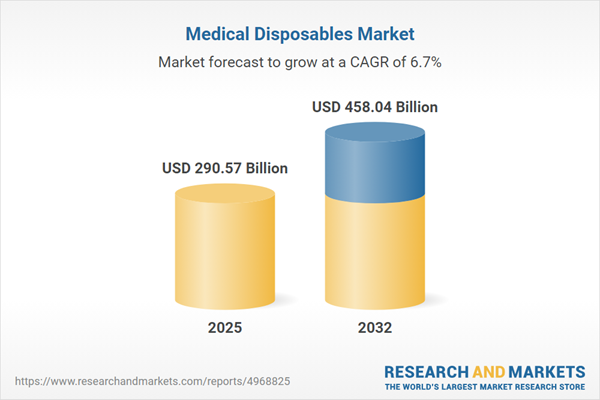Speak directly to the analyst to clarify any post sales queries you may have.
The medical disposables market is evolving rapidly, presenting leaders across healthcare and manufacturing with opportunities to drive efficiency, safety, and sustainability amid ongoing regulatory, technological, and market changes. Effective procurement and resilient strategies are increasingly integral as demand grows for innovative, patient-centric single-use products.
Market Snapshot: Medical Disposables Market Expansion
The global medical disposables market grew from USD 272.04 billion in 2024 to USD 290.57 billion in 2025 and is projected to exhibit a compound annual growth rate (CAGR) of 6.72%, reaching USD 458.04 billion by 2032.
Scope & Segmentation
Comprehensive coverage offers actionable insights across the supply and demand spectrum of the medical disposables market. This research analyzes current dynamics and future opportunities across:
- Product Types: Diagnostic & Laboratory Disposables, Drug Delivery Products, Incontinence Products, Infusion & Dialysis Products, Respiratory Disposables, Surgical Disposables, Wound Management Products
- Raw Materials: Nonwoven Fabrics, Paper & Paperboard, Plastic Resins, Rubber & Latex
- End Users: Ambulatory Surgical Centers (ASCs), Clinics, Diagnostic Centers, Home Healthcare Settings, Hospitals
- Distribution Channels: Direct Procurement, Online Distribution, Retail Pharmacies
- Region Coverage: Americas (including North America and Latin America: United States, Canada, Mexico, Brazil, Argentina, Chile, Colombia, Peru), Europe, Middle East & Africa (featuring major and emerging economies in Europe, the Middle East, and Africa), Asia-Pacific (including China, India, Japan, Australia, South Korea, Indonesia, Thailand, Malaysia, Singapore, Taiwan)
- Key Companies: Analysis includes 3M Company, Becton, Dickinson and Company, Cardinal Health, Inc., Baxter International Inc., Medtronic plc, B. Braun Melsungen AG, Owens & Minor, Inc., Smith & Nephew plc, Terumo Corporation, Mölnlycke Health Care AB
Key Takeaways for Senior Decision-Makers
- The medical disposables market is shaped by continuous advancements in digital integration and manufacturing efficiency, creating responsive and agile supply chains for healthcare providers.
- Rising environmental mandates are pushing the adoption of recyclable polymers, biodegradable components, and circular economy principles across procurement and design.
- Regulatory divergence across regions necessitates adaptable compliance frameworks and localized strategies as governments strengthen quality, traceability, and sustainability guidelines.
- Industry leaders are accelerating partnerships focused on antimicrobial innovation, smart sensors, and advanced analytics platforms to enhance both product performance and operational visibility.
- The move toward distributed and regionalized production is improving supply chain resilience and mitigating volatility from shifting trade landscapes.
Tariff Impact and Cost Management Strategies
The 2025 United States tariff regime has led organizations to optimize their sourcing, with many diversifying suppliers and shifting manufacturing to alternative regions such as Latin America and Asia-Pacific. This evolving environment requires vigilant cost controls and lean manufacturing practice, while stimulating new investments in domestic capacity and digitalized procurement networks. Providers are adjusting contract structures to secure pricing stability amidst regulatory fluctuations.
Methodology & Data Sources
Our research leverages triangulated insights from senior executive interviews, expert panels, and site visits, corroborated with secondary analysis from industry publications, regulatory filings, and government databases. Data integrity is maintained with advanced statistical modeling and peer validation at every review phase.
Why This Report Matters
- Enables strategic planning through detailed segment analysis and regulatory tracking, equipping leadership with actionable forecasts and trend identification across the medical disposables market.
- Provides benchmark data and qualitative insights supporting procurement, investment, and innovation decisions for manufacturers, healthcare organizations, and investors.
- Highlights technology adoption and sustainability trajectories critical for remaining competitive and operationally resilient in evolving global healthcare supply chains.
Conclusion
The medical disposables sector is defined by agile adaptation, advancing technology, and heightened regulatory focus. Strategic alignment of innovation, resilience, and sustainability will remain vital to capturing future growth and addressing dynamic healthcare needs worldwide.
Additional Product Information:
- Purchase of this report includes 1 year online access with quarterly updates.
- This report can be updated on request. Please contact our Customer Experience team using the Ask a Question widget on our website.
Table of Contents
3. Executive Summary
4. Market Overview
7. Cumulative Impact of Artificial Intelligence 2025
Companies Mentioned
The companies profiled in this Medical Disposables market report include:- 3M Company
- Becton, Dickinson and Company
- Cardinal Health, Inc.
- Baxter International Inc.
- Medtronic plc
- B. Braun Melsungen AG
- Owens & Minor, Inc.
- Smith & Nephew plc
- Terumo Corporation
- Mölnlycke Health Care AB
Table Information
| Report Attribute | Details |
|---|---|
| No. of Pages | 182 |
| Published | November 2025 |
| Forecast Period | 2025 - 2032 |
| Estimated Market Value ( USD | $ 290.57 Billion |
| Forecasted Market Value ( USD | $ 458.04 Billion |
| Compound Annual Growth Rate | 6.7% |
| Regions Covered | Global |
| No. of Companies Mentioned | 11 |









